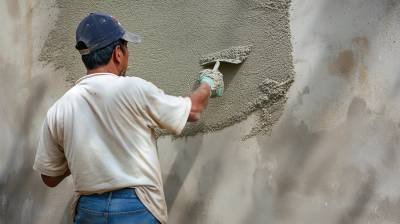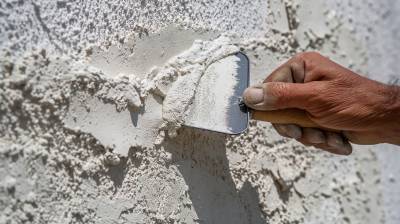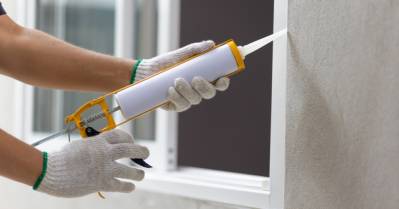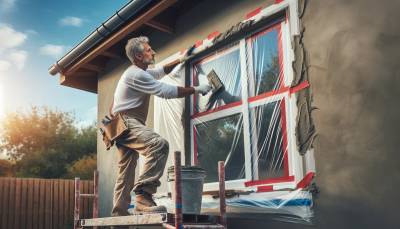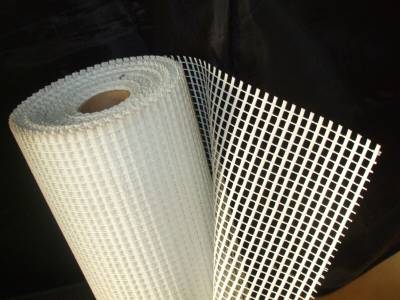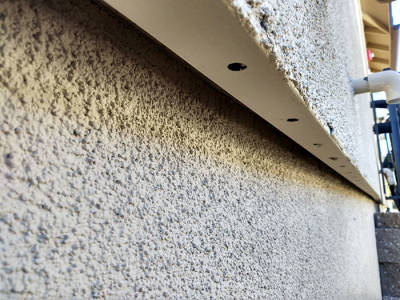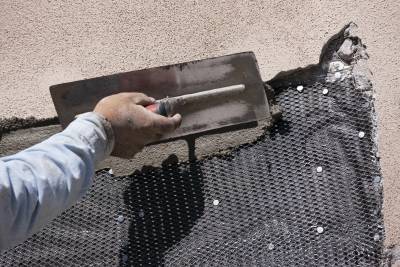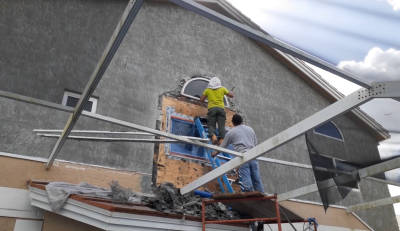Stucco lath, an essential skeleton for stucco installations, has been in use for centuries in the construction industry. This technique is vital for providing a secure base on which the stucco mix can be applied. Understanding the intricacies of stucco lath is critical for anyone considering stucco installations or those researching various stucco techniques and processes.
Understanding Stucco Lath
Stucco lath, often referred to as stucco netting, is metal lathing used as a reinforcement for the stucco during application. It's a primarily mesh-like substrate made up of wires woven together to create an interlocking system. This system can be fastened onto a structure's wall, providing a strong reinforced area on which stucco can be applied securely.
The Purpose of Stucco Lath
The primary purpose of stucco lath is to create a sturdy foundation for the stucco mix, enabling the stucco to adhere better to the construction surfaces. By doing so, it increases the stucco's durability and life. Without a lath, the stucco, which in itself is a heavy mixture, would not seamlessly stick to the surfaces, ultimately risking the stucco layers peeling or falling off over time.
Types of Stucco Lath
There are various types of stucco lath used in different settings based on the specifics of a project. Awareness of the types can help you choose the right lath for your stucco project.
- Metal Lath: Metal stucco lath is widely used due to its durability and strength. It is suitable for both interior and exterior stucco applications.
- Fiber Lath: Fiber lath is a modern alternative to metal lath, made predominantly from fiberglass. It is lightweight and easier to manage, making it a favorite among DIY enthusiasts.
- Wire Lath: A common type of stucco lath, wire lath is made up of woven wires and often comes in rolls or sheets that can be easily tailored to fit different areas.
Choosing the Right Stucco Lath
The choice of stucco lath depends largely on the scale of the project, the surface onto which the stucco will be applied, and the climate or weather of the region. For instance, metal lath might be the preferred choice for larger projects with more structural demands, while fiber lath might be the go-to for smaller, do-it-yourself projects.
Installing Stucco Lath
The process of installing stucco lath can be broken down into a few pivotal steps. Although it's recommended to have experienced professionals conduct the process, it's beneficial to understand the basics of the installation procedure. This knowledge allows you to better assess the progress of your project or consider tackling it on your own if you're up for the challenge.
1. Surface Preparation
The first step involves preparing the surface onto which the stucco lath will be applied. This could involve cleaning the surface, removing debris or old paint, and making sure the wall (wood, masonry, etc.) is ready for lath placement.
2. Attaching the Lath
The next step involves fastening the stucco lath onto the prepared surface. During this step, the lath must be carefully attached to ensure a secure foundation for the stucco application. Depending on the type of lath, methods such as stapling or nailing may be used.
3. Applying the Scratch Coat
Following the lath attachment, a base coat or 'scratch coat' of stucco is applied. Before this dries, horizontal lines are made in the coat, giving it a "scratched" look. This helps the subsequent coats adhere better to the base.
4. Final Coats
After the scratch coat, final coats of stucco are applied. These might be color coats or finishing coats, depending on the desired final look of the stucco application.
Stucco lath is an integral element in the stucco installation process. It plays a crucial role in ensuring the stucco adheres to the application surface and enhancing the durability and longevity of the stucco coating. Whether you're new to the world of stucco installations or are an experienced professional in the field, understanding the role, types, selection, and process of stucco lath installation is essential knowledge.
Frequently Asked Questions About Stucco Lath
How is stucco lath installed?
Stucco lath is attached to the exterior building structure using nails or screws. Once the lath is attached, a coat of stucco base is then applied to form a strong, moisture-resistant barrier. The installation process should be done professionally to ensure it's properly installed, preventing any potential issues in the future.
What is the purpose of a lath in a stucco wall system?
The lath in a stucco wall system helps to firmly anchor the stucco to the wall's surface. This is crucial to provide structural support and prevent the stucco from sagging or falling off. Furthermore, the lath also facilitates the proper adhesion of the stucco to the wall, creating a seamless and durable finish.
What is the difference between stucco lath and plaster lath?
Stucco lath and plaster lath serve similar purposes, but they are used in different contexts. Plaster lath is typically used for interior surfaces while stucco lath is designed for exterior surfaces. Due to different environmental conditions, these laths are constructed from different materials and have specific installation requirements.
Why is stucco lath important for the durability of the stucco?
Stucco lath plays a pivotal role in the overall durability of the stucco. It provides not only support for the weight of the stucco, but also a textured surface for the stucco to adhere to. Without the lath, the stucco would be more likely to crack, fail, or fall off the building over time.
Can I install stucco lath myself, or do I need a professional?
While it's technically possible to install stucco lath yourself, it's generally recommended to hire a professional. Stucco lathing requires a clear understanding of building codes and material handling, as well as precision in installation. Incorrect installation can lead to a variety of problems, including moisture infiltration and stucco failure.
Are there any special tools required for installing stucco lath?
Installing stucco lath requires a variety of specific tools. These include a hammer or drill for securing the lath, shears for cutting the lath, and safety equipment like gloves and goggles. A lath installation also requires a lath fastener to ensure the lath is securely attached to the building.
What happens if stucco lath is not installed correctly?
If stucco lath is not installed correctly, it can lead to several problems including cracking, breaking, sagging, and even complete failure of the stucco. Also, incorrect stucco lath installation can make the wall more susceptible to water damage and insect infestations. Hence, it is crucial to ensure it's installed correctly.
Pros and Cons of Stucco Lath
Pros of Stucco Lath
Durability
One of the most significant advantages of stucco lath is its durability. With proper installation and maintenance, a stucco lath can last for several decades. This can be attributed to:
- Stucco lath's natural resistance to fire, rot, and insects.
- The combination of stucco's cement, sand, and lime creates a robust finish.
- Stucco lath's compatibility with various climatic conditions.
Cost-effective
Stucco lath is relatively affordable compared to other similar materials. This is due to:
- The materials used in stucco lath—cement, sand, and lime—are inexpensive.
- The durability of stucco lath, which reduces the need for replacements or repairs.
- The low maintenance requirements of stucco lath.
Easy Installation
The installation process of stucco lath is straightforward and less complicated compared to other similar processes.
Versatility
Stucco lath can be designed and colored in various ways, allowing for high levels of customization in building designs. It can be made to mimic other materials, such as brick or stone, and can be painted any color.
Energy Efficiency
Stucco lath provides excellent insulation, which can lead to significant energy savings by reducing the need for heating and cooling.
Cons of Stucco Lath
Moisture Concerns
One primary disadvantage of stucco lath is its vulnerability to moisture. This is due to:
- An improper installation or cracks in the stucco can allow water to seep in, leading to mold growth and structural damage.
- Stucco lath is less efficient in climates with heavy rainfall.
Difficulty in Modifying
While stucco lath is versatile in its design possibilities, once it is installed and dried, it can be very difficult and costly to modify or repair.
Long Drying Time
Stucco lath requires a long drying time, which can lengthen the overall construction process.
Limited Applicability
Even though stucco lath works well in a variety of climates, it does not fare well in areas with consistently high humidity or frequent heavy rains.
Maintenance
While stucco lath doesn’t require intensive upkeep, it needs regular maintenance to prevent cracks, as it is not as flexible as some other materials. Additionally, if painted, the paint may need to be refreshed every few years.
Summary
Stucco lath is widely used in construction for holding the plaster in place, making it an essential part in building robust and resilient structures. The use of a good quality stucco lath not only ensures durability but also greatly enhances the aesthetic appeal of the buildings. Thus, the role of stucco lath in construction goes beyond just being functional; it significantly contributes to the overall value of the property.
It's clear that stucco lath has various types, with each having its unique set of advantages. Although metal lath is widely preferred due to its strength and durability, other types like wooden lath hold their own significance and may be used based on the requirements of the project. Thus, understanding the unique benefits of each type of stucco lath helps in making informed choices that deliver efficiency, longevity, and aesthetic beauty to the building structure.
The installation process of stucco lath is just as important as the choice of lath itself, contributing significantly to the final results. A careful and precise installation process helps in achieving a flat and clean surface that supports efficient plaster adhesion. If not installed properly, the stucco may develop cracks over time, leading to durability issues in the long run. Therefore, proper installation of stucco lath is crucial for the longevity and aesthetic appeal of any building structure.
About Atlas Stucco
Welcome to Atlas Stucco, your trustworthy partner for all stucco-related needs in Sacramento, CA. With decades of industry expertise, we're committed to delivering top-notch services across the stucco spectrum, from initial installations, inspections, repairs to enduring maintenance services. Our professional team takes immense pride in maintaining the highest standards of craftsmanship, ensuring your home or business stands out with a distinct and enduring appeal. We’re driven by customer satisfaction and couldn’t be more thrilled to help you realize your vision for a stunning finish, one stucco project at a time.
Tags: stucco lath, stucco installation, building materials,





